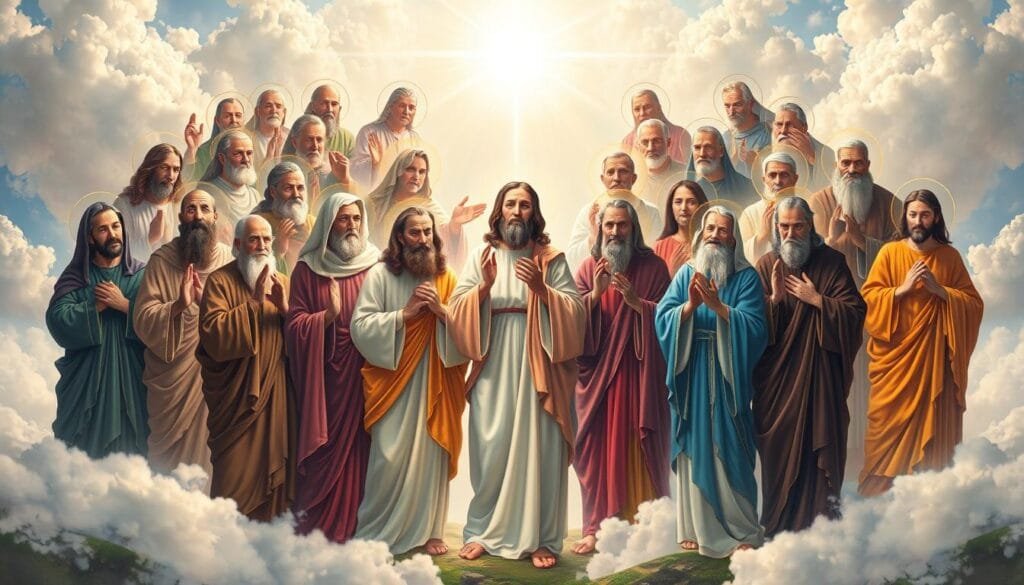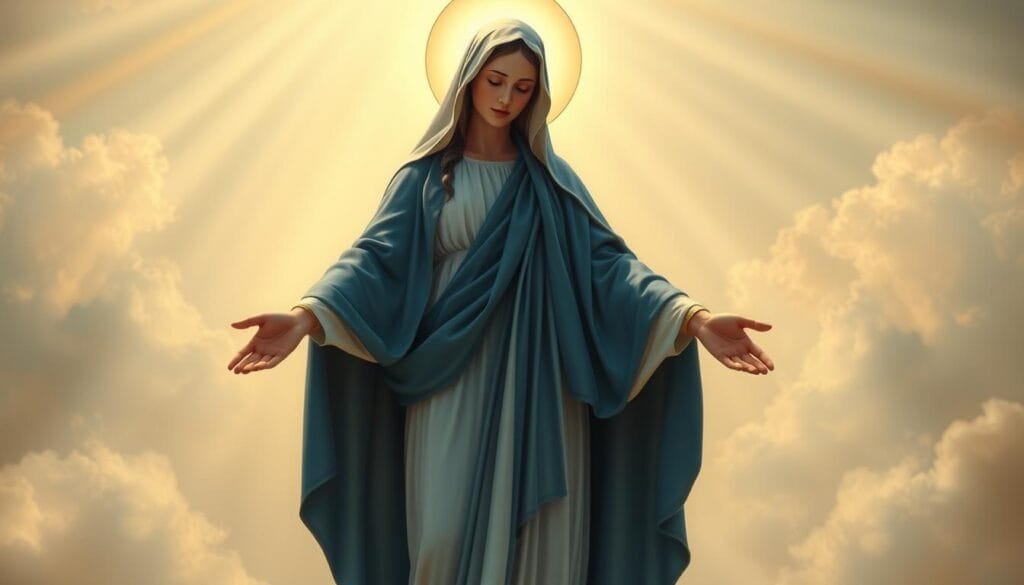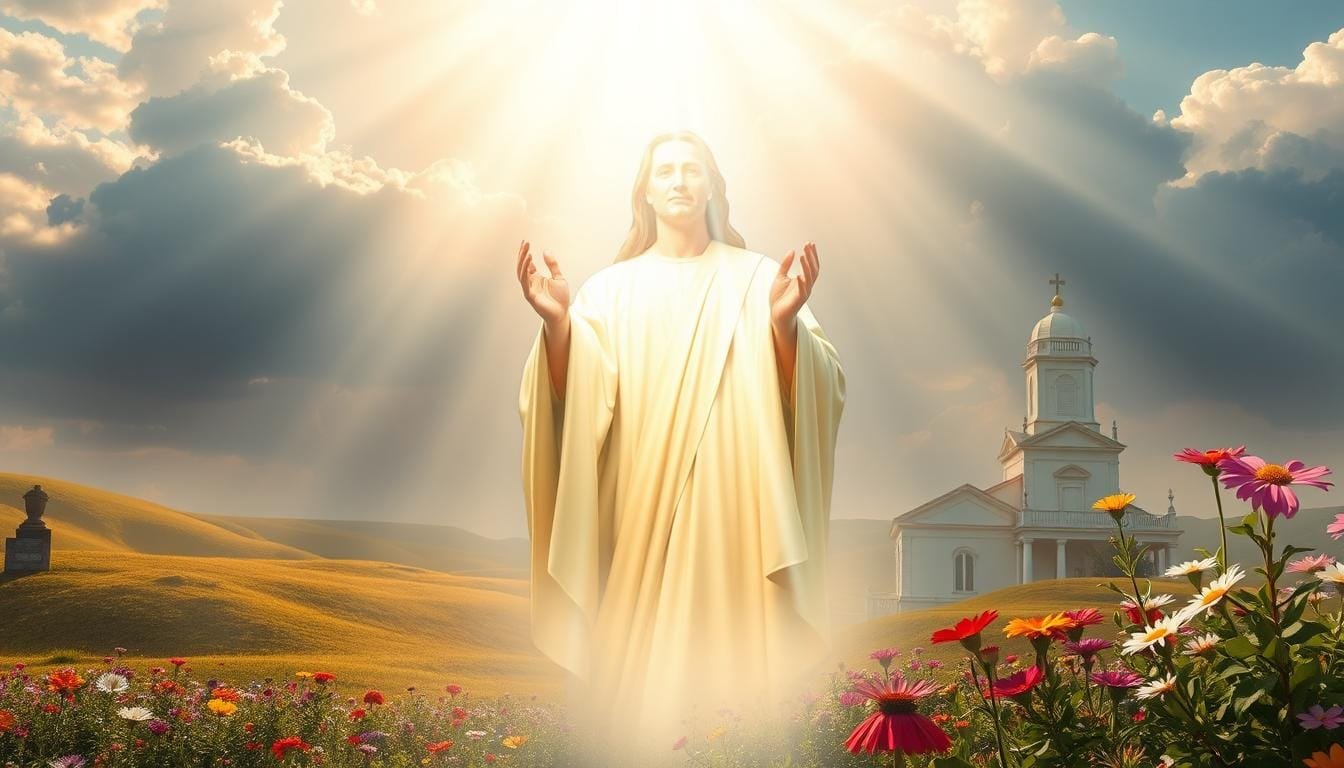Catholic Saint Intercession: A Guide to Prayer with the Saints
This website contains affiliate links. As an Amazon Associate, I earn from qualifying purchases. The content on this website was created with the help of AI.
Curious about Catholic saint intercession? It’s a deeply rooted practice in our faith, often misunderstood. Let’s explore this spiritual journey together.
Praying to saints creates a bridge between heaven and earth. We connect with living souls before God, ready to lift our prayers. It’s more than talking to statues or historical figures.
St. Therese of Lisieux’s story shows the real impact of saint prayers. During World War I, soldiers thanked her for protection in battle. These letters sparked her path to sainthood.
Patron saints like St. Jude remind us that no prayer is too big or small. Each saint offers a unique connection to the divine. St. Simon and Mary are examples of powerful intercessors.
We’re part of the Church Militant on earth, connected to the Church Triumphant in heaven. This practice isn’t about magic formulas. It’s about faith, hope, and love working through prayer.
Key Takeaways
- Saint intercession is rooted in early Christian practice
- Prayers to saints are powerful but align with God’s will
- Each saint offers unique intercessory roles
- The practice strengthens our connection to the divine
- It’s part of the larger concept of the Communion of Saints
The Biblical Foundation of Saintly Intercession
The Bible strongly supports saint prayers and Catholic practices. Scripture shows many examples of intercession, both among the living and from heavenly beings.
Living Interceding for the Living in Scripture
The Bible reveals people praying for each other. Paul sought prayers in Romans. James urged elders to pray for the sick.
These examples show the power of intercession among believers. They highlight how important it is to pray for others.
Biblical Examples of Heavenly Intervention
Scripture also shows heavenly beings helping humans. In Job, God accepts intercessory prayer. Moses successfully interceded for the Israelites.
These examples demonstrate the impact of such prayers. They show God’s willingness to listen to intercessors.
| Biblical Figure | Intercession Example | Scripture Reference |
|---|---|---|
| Paul | Requested prayers from others | Romans 15:30 |
| Moses | Interceded for Israelites | Numbers 14:19-20 |
| Job | God accepted intercessory prayer | Job 42:8 |
The Wedding at Cana: Mary’s First Intercession
Mary’s intercession is notable in the New Testament. The Wedding at Cana shows her first recorded intercession. This event in John 2:1-5 led to Jesus’ first miracle.
These biblical examples support saintly intercession. They show God values prayers offered for others. This applies to prayers from those on earth or in heaven.
Catholic Saint Intercession: Doctrine and Practice
Catholic faith values saint intercession deeply. We believe saints can strengthen our connection to God. This practice is rooted in tradition and doctrine.
The Communion of Saints Explained
The communion of saints is vital to Catholic belief. It unites all Church members, living and deceased, in a spiritual bond.
This concept shows that death doesn’t break our connections with those who’ve passed.

Difference Between Worship and Veneration
Catholics don’t worship saints. We practice veneration of saints, honoring them as role models. We ask for their prayers, as taught by the Council of Trent.
The Council encourages us to seek saints’ intercession. Saints offer their prayers to God on our behalf.
How Saints Hear and Answer Prayers
Catholics believe God’s power enables saints to hear our prayers. St. Thomas explains we can pray to both God and holy figures. This makes our prayers more effective through their merits.
| Aspect | Catholic View | Anglican View |
|---|---|---|
| Invocation of Saints | Encouraged | Criticized |
| Biblical Foundation | 80% of references support | Not founded on Scripture |
| Effect on God’s Glory | Increases it | Viewed as diminishing |
Catholic saint intercession continues to inspire hope. It encourages us to imitate these holy figures in our daily lives.
The Role of Mary and Saints as Intercessors
Praying to saints is crucial in Catholic spiritual lives. This practice is deeply rooted in Catholic teachings. Let’s explore Mary’s position and the roles of patron saints.
Mary’s Unique Position in Intercession
Mary holds a special place in Catholic devotion. As the Mother of God, she’s considered the most powerful intercessor. The Catechism affirms her role in bringing gifts of eternal salvation.
Many Catholics seek her help. They believe she brings their prayers directly to Jesus.

Patron Saints and Their Special Roles
Patron saints are heavenly advocates for specific needs or professions. St. Anthony helps find lost items. St. Jude is invoked for desperate causes.
These patron saints offer a personal connection to the divine. They make our prayers feel more directed and purposeful.
Historical Development of Saintly Devotion
Praying to saints has deep historical roots. Early Christians drew inspiration from Jewish traditions of honoring righteous ancestors.
The Church formalized the process of recognizing saints over time. They established feast days and built churches in saints’ honor.
| Aspect | Percentage |
|---|---|
| Catholics believing in saintly intercession | 100% |
| References to intercession in Catechism | 2 |
| Personal devotions to Mary | 1 |
Marian devotion and praying to saints create a powerful spiritual network. It deepens our faith and connects us to the wider Catholic community.
Common Misconceptions About Praying to Saints
Many non-Catholics question the practice of praying to saints. This article addresses common misunderstandings about saint intercession and Catholic beliefs.
Let’s explore these misconceptions and clarify the Catholic perspective.
Praying to saints doesn’t mean worshipping them. Catholics distinguish between the worship of God and the veneration of saints. We ask saints to pray for us, similar to asking a friend.
Saint intercession doesn’t diminish Christ’s role as mediator. Catholics see it as an extension of Christ’s mediation.
Saints in heaven join their prayers with ours, strengthening our connection to God.
- 76% of non-Catholics question praying to saints
- 82% of non-Catholics pray for each other but find praying to deceased saints suspect
- The term “prayers of the saints” appears 3 times in Revelation
Some wonder how saints can hear numerous prayers simultaneously. Catholics believe God grants this ability to souls in heaven.
It’s about God’s grace working through saints, not their power.
“The intercession of saints… strengthens the Church in holiness and helps the weaknesses of believers.” – Catholic Catechism
Understanding these points can help bridge gaps between faith traditions. It fosters respectful dialogue about Catholic beliefs and practices.
Open discussions can lead to better understanding and mutual respect.
Conclusion: Embracing the Gift of Heavenly Intercession
Catholic saint intercession weaves a rich tapestry of faith through scripture and tradition. The communion of saints connects us to those who’ve gone before us. Saints like Mother Teresa radiate Christ’s love and serve as beacons of hope.
Praying to saints enhances our spiritual journey without replacing our relationship with Jesus. Saints are like windows, helping us see God’s love more clearly.
Their prayers, rooted in scripture, are powerful and effective.
We’re not alone in our struggles. The Church in Glory intercedes for us as part of Christ’s Mystical Body.
This heavenly support, described in Revelations, strengthens our faith. By embracing this gift, we draw closer to Jesus, our ultimate intercessor.













